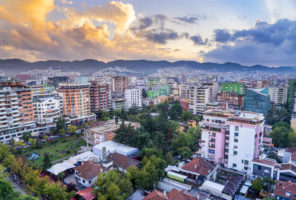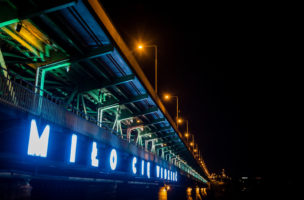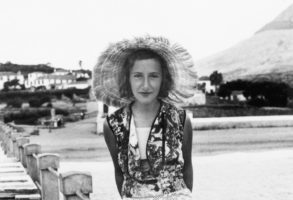Support Hidden Compass
We stand for journalism, science, history, and hope. Make a contribution to Hidden Compass and stand with us.
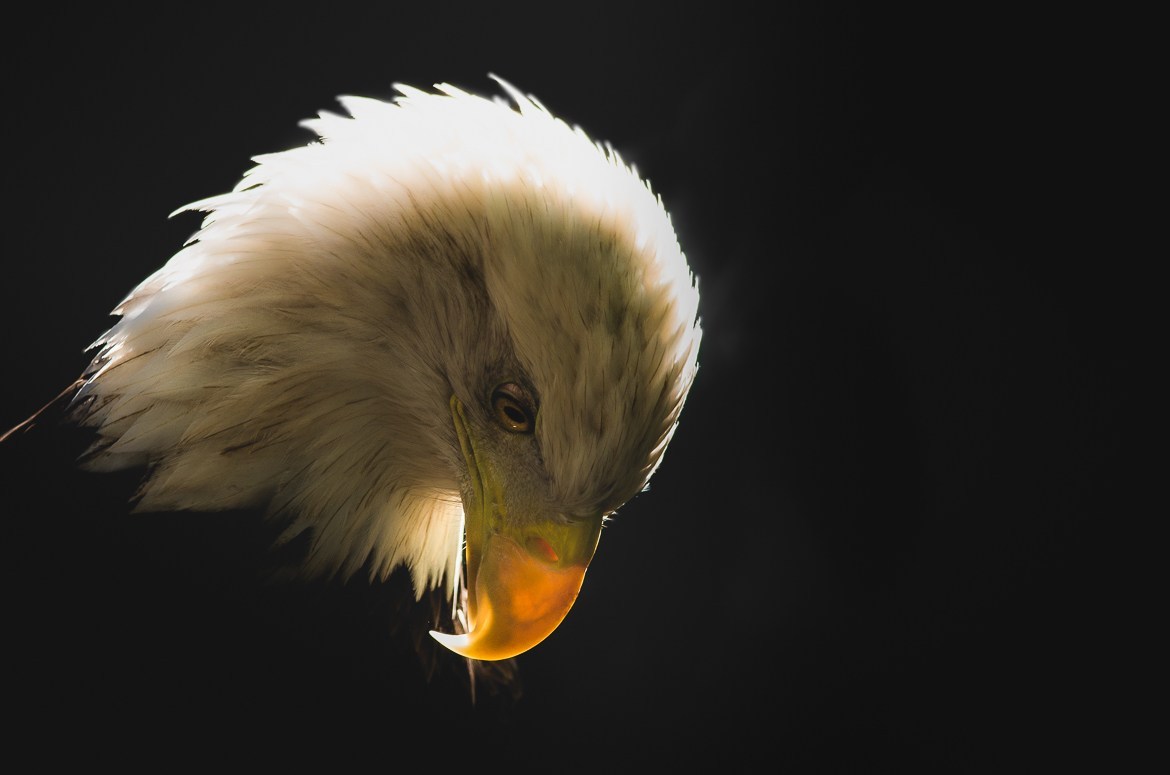
The blazing white head and flesh-tearing hooked bill of a bald eagle. Standing nearly four-feet tall with a wingspan of up to eight feet, the birds are among the largest in North America. PHOTO: BIR HUNDGENN.
The paddle felt light in my hands as it sliced through the mirror of the water, pulling me and my kayak forward with each stroke. By afternoon, the winds would blast through the archipelago of Haida Gwaii, roiling the sea and making passage more difficult. But for now, in the early morning, the air was so tranquil that I could hear the deep whoosh of a humpback whale exhaling out its blowhole from a quarter mile away.
“Stop paddling for a second,” my partner Jean-Francois said from the seat behind me.
I brought the paddle to rest across the bow of the kayak and turned to look at him, catching a salty-sweet whiff of fresh ocean air.
“Listen,” he said, smiling.
I turned back around and tuned in. Among the calls of seagulls, I began to make out an odd guttural bellow. A chorus of bellows, in fact. Sea lions.
I dipped my paddle into the water again, with a grin that matched his.
But even on this calm morning in the kayak, among the levity of wildlife encounters, my mind brooded. Questions not yet fully formed in my head were already begging for answers.
Five days prior, we’d flown 1.5 hours from Vancouver to Haida Gwaii, landing in the hamlet of Sandspit, population 300. From Sandspit’s mid-archipelago location on Moresby Island, we’d hopped aboard a shuttle van and bounced an hour down a dusty logging road to a bay, then bumped another four hours on a Zodiac boat tracking south through the heaving waters of Hecate Strait. When we finally reached Gwaii Haanas National Park Reserve, our guide was waiting.
“Welcome home,” Jess said, as we clambered off the Zodiac.
We were standing at the edge of 370,000 acres of coastal temperate rainforest, spread among dozens of islands and islets. Gwaii Haanas National Park Reserve contains no roads, or even hiking trails. The islands have never been logged and are reticulated with channels rinsed twice a day by the Pacific tide, yielding some of the most pristine and life-rich waters on earth. I’d read that not even the glaciers of the last ice age had touched this place. Our group of eight would be navigating the network of waterways by kayak, camping in a different cove every night.
The eagle had told me something. I just hadn’t yet figured out what.
I’d come to Haida Gwaii simply to experience it. Living in the era of climate change, with ever-more destructive wildfires and hurricanes, I was increasingly drawn to places that felt immortal. And, if I was being honest with myself, since turning 40, I’d been thinking more about what it means to be living the second half of my life — the one that inevitably ends in death.
“Stay left of the rock!” Jess called out from the lead kayak.
I looked ahead and identified the crag poking out above the water line. “See it?” I asked Jean-Francois.
“Yep,” he said, and I felt our tandem kayak adjust course ever so slightly as he shifted the rudder.
As we got closer, I could make out an eagle standing atop the rock, facing our oncoming kayaks. She was the biggest bird I’d ever seen, nearly four-feet tall, and unmistakable, not only for her size, but also for her distinctive coloring: blazing white head, dark chocolate feathers, and an unmistakable, banana-yellow bill chiseled to a flesh-tearing hook at the end. She didn’t register our approach, just continued gazing out over the open water. Hunting fish, I presumed.
I knew the right thing to do was to give the eagle a wide berth and paddle even further left. But I felt a magnetic pull to her. Jean-Francois must have felt it, too, because he held our line.
The wind started to pick up, gusting at our backs, pushing us so that we barely had to paddle as we slid past the eagle. We were so close I could see individual feathers on her breast and wings, even her face. Her feathers ruffled in the breeze, blown back a bit from the rest of her body, giving her the even more majestic appearance of being cloaked in a flowing robe. She turned her head ever so slightly as I passed. It was the first time I’d seen a bald eagle at eye-level.
I felt strangely calm. No compulsion to pull my camera out of the dry bag to get a photo. No need to call out to the others in the group, “Oh my God, did you see that?”. Even as we paddled on to our next camp and the winds came into their full afternoon apex, tossing our kayaks around in the waves and splashing cold water into my face, I felt grounded and steady inside my kayak — inside my skin.
The eagle had told me something. I just hadn’t yet figured out what.
~~
On our first day, immediately after we’d set up camp, I’d taken a walk in Haida Gwaii’s storied woodlands. A living carpet of lime-green moss covered every inch of the forest floor with old giants rising from it: red cedar, western hemlock, Sitka spruce. Trees the size of grain silos.
“These were seedlings when Columbus landed,” Jean-François had whispered, awestruck.
I’d been awestruck too, but I’d also felt a stab of envy at their long lives. How was 80 years, or 86 years — or whatever the average life expectancy is for American women these days — ever going to be enough?
I’d stepped around one particularly huge, gnarled spruce that was apparently in the process of swallowing a boulder — the bottom portion of its trunk a mass of root-wrapped rock. The sight troubled me and I stopped and looked back to ensure I’d be able to find my way out. It seemed too easy. If I lost sight of the ocean through the velvety understory, I might never find it again. Just like it swallowed the boulder, the forest might swallow me, too.
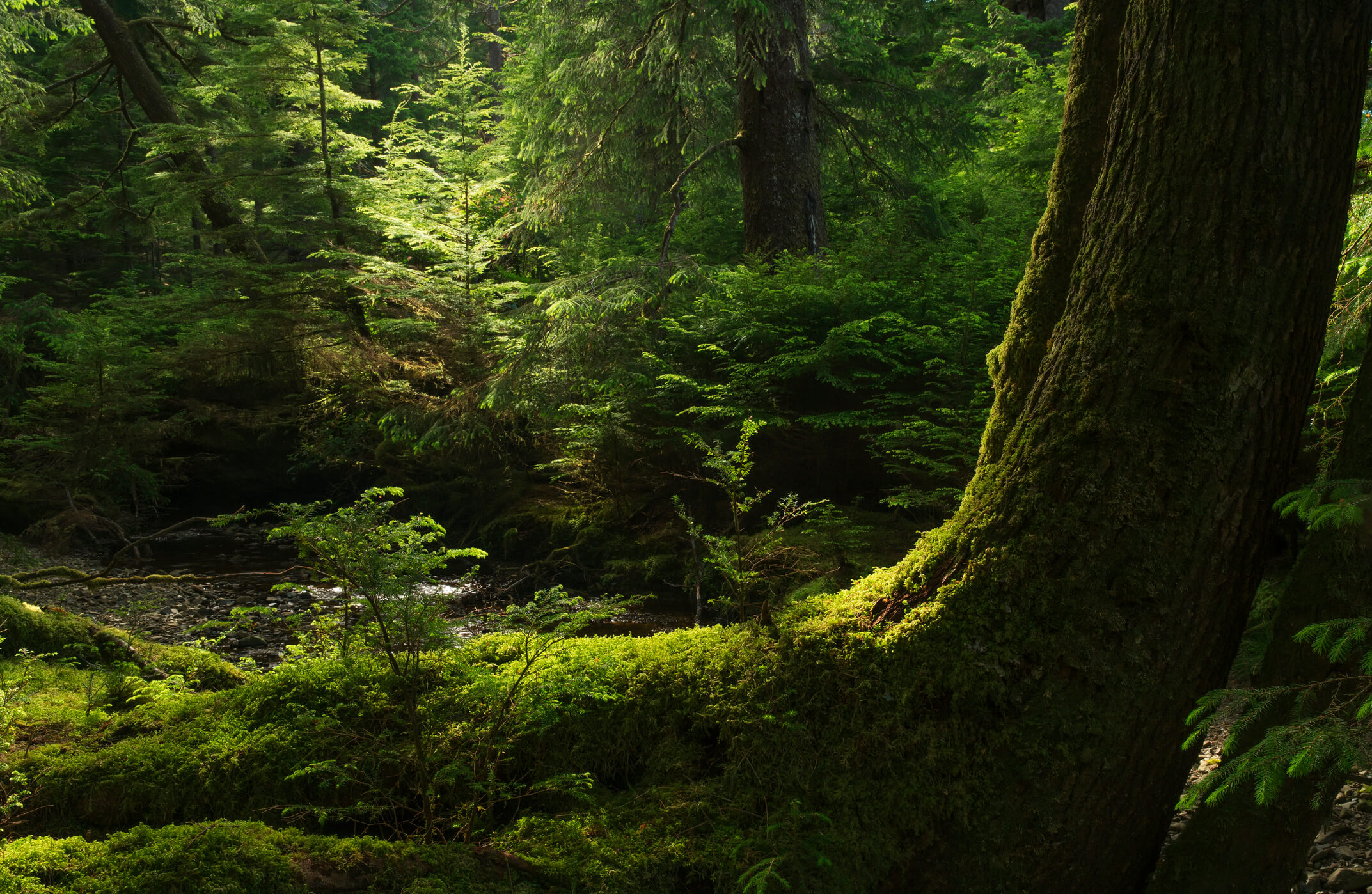
Light shines through the forests of Haida Gwaii. To author Jayme Moye, the untouched forests feel immortal. PHOTO: ROBERT POSTMA / DESIGN IMAGES.
As untamed as Haida Gwaii’s forests had felt to me, we were far from the first people to step inside. Shortly after the eagle encounter, we met David, a member of Haida Gwaii’s indigenous people. The Haida have lived on the archipelago for an estimated 12,500 years. Tall and lanky with a crooked grin and friendly eyes, David works for Parks Canada as part of the Haida Gwaii Watchmen Program. From May to September, he and three other Watchmen live on the deserted island of SGang Gwaay to protect an ancient Haida village site known as SGang Gwaay Llnagwaay.
SGang Gwaay Llnagwaay is a glimpse into another world, from another time. There, in a sheltered bay on the east side of an island, mammoth wooden beams mark former longhouses where Haida families once lived. And died. Mortuary poles, carved from red cedar trees to represent animals, people, and supernatural beings, tower overhead in various stages of decay, marking the graves of high-standing villagers.
Just like it swallowed the boulder, the forest might swallow me, too.
David was careful about where we stepped. He’d laid sea shells on the moss to delineate where we should walk. Relics, and spirits, he said, were everywhere. At one point, David stopped and chuckled. “See that?” he said, pointing to a line of shells. “That’s Raven.”
“What’s Raven?” I said, peering at the row.
“The shells on their back,” David said. “That’s Raven’s work. I put them one way, and he flips them the other.”
I looked again and saw that a couple of the shells were indeed flipped over; their concave side facing up.
“But why?”
“Because Raven is smart,” said David. “When the shells face up, they collect rainwater for Raven to drink.” He paused and grinned. “And because Raven’s a trickster. He symbolizes humor, taking a lighthearted approach to life.” David started walking again.
“What about eagles — err — Eagle then?” I said, matching his pace. “What does it symbolize?”
“Eagle is a spiritual guide, a connection to a higher realm,” David said.
~~
On the last day, Malcom, a fellow paddler, went for a walk in the forest after lunch. “I found a dead eagle back there,” he said on his return. “It’s in good shape; like it just fell from the sky.”
I listened intently as he tried to recall the exact location. I imagined tucking a perfectly preserved feather into my pocket as a souvenir, a piece of Haida Gwaii I could carry with me. We broke up into groups of twos and threes to search. Jean-Francois and I tromped off together. Malcolm had recalled the bird lying in a little indentation in the ground, at the base of a tree, just over a ridgeline.
Jean-François and I picked our way through the chaos of moss and ferns and shrubs and roots and rocks that encompass the understory. We negotiated several nurse logs — massive trees that had fallen over and died, their decaying trunks now serving as a launching point for a new lineup of trees, straight as arrows, striving for the canopy. All around us, things were growing and decaying, the overlapping beginnings and endings blurring the lines between life and death. Things in Haida Gwaii, I noted, are never one or another, but merely on their way between the two.
After a few minutes of searching, we found the ridgeline and separated to cover more ground. I traced the base, working my way back toward the ocean, while Jean-François combed the top. Then I heard my name. The youngster of our group, a college student named Harrison, had found something. I hurried toward the sound of his voice.
Eagle lay at the base of a hemlock, on a swath of moss just below the place where the roots dove into the soil. He was face up, his wings folded back exposing his breastbone and his talons. The feathers of Eagle’s head and body, along with the organs, had disintegrated into the earth, already feeding the tree. The long, broad feathers of his wings and tail, however, were still fully formed, giving the appearance of a winged skeleton in mid-flight — alive even in death.
Eagle was considerably smaller than the one standing on the rock I’d passed days earlier, and his beak was black not yellow. But to a birder like me, a bald is obvious. “This is a bald eagle,” I told the others.
“Wait, so bald eagles’ beaks turn black after they die?” Jean-François said.
“No,” I said. “They are black when they’re born.”
Eagle was a juvenile. Probably 1-2 years old based on the color of his bill and what remained of his plumage.
The others chattered around me, speculating about how Eagle had passed, but I didn’t join the discussion. Instead, I sat cross-legged at Eagle’s feet and observed the place where he’d taken his last breath. The chief of the sky, as the Haida called him, had chosen the forest for his final resting place. If I were an eagle, I thought, I would have done the same. Death, at least among the old-growth trees of Haida Gwaii, felt less final — part of a greater whole, a cycle. In the many tangible ways I’d seen in the forest, the end of one life was just the start of another.
I reached out and gently stroked Eagle’s wing. The feathers on the edge shifted just enough that I knew they were no longer attached. I gingerly lifted the outermost wing feather, holding it between my thumb and forefinger, admiring the way it tapered to a firm point at the end. I exhaled. And set it back down. I turned to look at Jean-François.
“It’s time to go,” I said.
He followed me back to the beach, and for a while neither of us spoke. When we stepped out of the forest, he reached for my hand. “Why didn’t you take that feather?”
“I’m not sure,” I said. “It didn’t feel right.” It wasn’t right; you’re not supposed to remove natural objects like feathers and seashells from national parks. But that wasn’t what had stopped me.
It wasn’t until the next day, when I was about to leave Haida Gwaii, that I better understood.
Back in Sandspit with Jean-François, a couple of ravens caught my attention, making a racket with their caw-caw-caw, swirling around a lone spruce that stood between the road and the sea. I ran my eyes up the tree and spotted what appeared to be a juvenile bald eagle perched near the top.
I stopped. This bird had the same plumage the dead eagle would have had in life — more of a milk chocolate than the deep, dark brown of adults, with mottled white and brown wings, and a dark head (the white comes later). I stared up at the young eagle sitting calmly in the tree, seemingly impervious to the noisy ravens. Part of me wondered if it was really there.
In that moment, I understood that by the time I’d held the feather under the tree, I’d already gotten what I needed from Haida Gwaii: the beginnings of answers to those questions that had been forming in the back of my mind since I’d turned 40 — a new way to think about life and death, as more of a circle and less of a straight line. Perhaps, I thought, being swallowed back into the forest might not be something to fear. I knew then that I had left the feather exactly where it belonged.
“Is that …” Jean-François started to say looking up.
“That’s Eagle,” I said.
Jayme Moye
Jayme Moye is an American-Canadian writer based in the mountains of British Columbia.
Never miss a story
Subscribe for new issue alerts.
By submitting this form, you consent to receive updates from Hidden Compass regarding new issues and other ongoing promotions such as workshop opportunities. Please refer to our Privacy Policy for more information.

